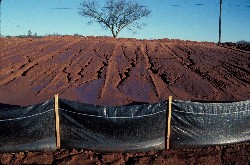|
 Runoff from agricultural and urban land is listed by the Environmental Protection Agency as the leading source of pollutants in U.S. waters. One of the major pollutants in waterways today is sediment, with over 4 billion tons lost each year as a result of erosion. Deposition of sediment in streams, lakes, and other waterways can cause long-term ecological and economic problems in both rural and urban communities. Some practices for controlling sediment release include the use of permeable barriers such as silt fence, stiff grass hedges, or straw hay bales. Silt fence is a geotextile fabric fastened to wooden or steel posts, with a wire mesh fence occasionally attached for structural support. Silt fence acts as a temporary dam by impounding runoff and allowing sediment to settle. Runoff from agricultural and urban land is listed by the Environmental Protection Agency as the leading source of pollutants in U.S. waters. One of the major pollutants in waterways today is sediment, with over 4 billion tons lost each year as a result of erosion. Deposition of sediment in streams, lakes, and other waterways can cause long-term ecological and economic problems in both rural and urban communities. Some practices for controlling sediment release include the use of permeable barriers such as silt fence, stiff grass hedges, or straw hay bales. Silt fence is a geotextile fabric fastened to wooden or steel posts, with a wire mesh fence occasionally attached for structural support. Silt fence acts as a temporary dam by impounding runoff and allowing sediment to settle.
Laboratory research has been conducted on three woven silt fence fabrics to examine the hydraulic performance over a range of sediment-laden conditions. The fabrics were examined based on the flow rate exiting the fabric, trapping efficiencies, total suspended solids concentrations exiting the fabric, and the particle sizes of the sediment exiting the fabric. Each fabric exhibited distinct clear water flows, and sediment affected the performance of the fabric by altering the flow exiting the fabric. Results showed that a modified orifice equation predicts both clear-water and sediment-laden flows through the fabrics. The trapping efficiencies for the three fabrics ranged from 55 to 65%, and the study found that most of the sediment trapped by the fabrics was primarily classified as sand sized particles. of sediment-laden conditions. The fabrics were examined based on the flow rate exiting the fabric, trapping efficiencies, total suspended solids concentrations exiting the fabric, and the particle sizes of the sediment exiting the fabric. Each fabric exhibited distinct clear water flows, and sediment affected the performance of the fabric by altering the flow exiting the fabric. Results showed that a modified orifice equation predicts both clear-water and sediment-laden flows through the fabrics. The trapping efficiencies for the three fabrics ranged from 55 to 65%, and the study found that most of the sediment trapped by the fabrics was primarily classified as sand sized particles.
 Additional work at the laboratory has been conducted in the area of stiff grass hedges. Stiff grass hedges are used where more permanent barriers are required. One such application is the management of upland erosion where hedges may be used to assist in keeping the topsoil on the field and thereby reduce sediment delivery to the stream and river system. These hedges normally consist of narrow, parallel strips of stiff-stemmed grass planted close to the contour. The strips may be continuous, or they may be used locally to control ephemeral gullies or other areas of concentrated flow. Stiff grass hedges have been tested in the outdoor laboratory to determine performance characteristics such as the effectiveness of multiple hedge rows and the depth of ponded water at failure. The impact of vegetal debris on hydraulic performance of the hedges was also documented. Additional work at the laboratory has been conducted in the area of stiff grass hedges. Stiff grass hedges are used where more permanent barriers are required. One such application is the management of upland erosion where hedges may be used to assist in keeping the topsoil on the field and thereby reduce sediment delivery to the stream and river system. These hedges normally consist of narrow, parallel strips of stiff-stemmed grass planted close to the contour. The strips may be continuous, or they may be used locally to control ephemeral gullies or other areas of concentrated flow. Stiff grass hedges have been tested in the outdoor laboratory to determine performance characteristics such as the effectiveness of multiple hedge rows and the depth of ponded water at failure. The impact of vegetal debris on hydraulic performance of the hedges was also documented.
The silt fence research was conducted in cooperation with the Oklahoma State University Biosystems and Agricultural Engineering Department and the stiff grass hedges research has been conducted in cooperation with the USDA-ARS National Sedimentation Laboratory in Oxford, Mississippi.
For more information about sediment control, contact Sherry Hunt and Darrel Temple.
|